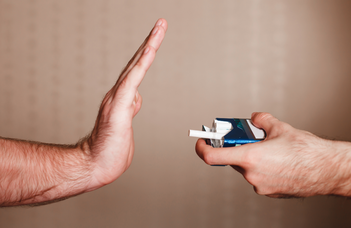Do the horrific pictures on cigarette packs have any effect on us?

Should I get insurance for low, medium, or high-risk? The website selling online insurance generally advises the medium one, and as we don’t want to waste time on in-depth information, we accept the offer. In this scenario, the impulse, which is known in science as the default nudge, worked; I decided because someone else (even an expert or a political decision-maker) thought it was suitable and ideal for me. But how reliable is this kind of subtle persuasion? Can we count on its effectiveness even if we wish to prevent a pandemic or minimize the number of lung cancer deaths caused by smoking?
Nudge, the theory of subtle signals, has been a success in psychology and behavioural economics in recent decades and is naturally popular among policy intervention designers. Who wouldn’t prefer the limits of official regulation, prohibition, and force to different types of persuasion and encouragement by example? So, it’s no surprise that the technique has quickly acquired traction among politicians who are worried about their popularity. To use another frequent example, we now know that the traditional nudge-based anti-Covid effort in England, which focused on the interests of the larger society and the preservation of the uninfected, was a failure. People did not willingly comply, and as the pandemic became out of control, authorities were forced to enforce harsh quarantine restrictions. Nonetheless, the nudge literature has been mainly effective in promoting nudge-based social reforms. Was the Covid campaign an exception or a mistake in the researchers’ calculations?
According to the study of Barnabás Szászi and Balázs Aczél, as well as their foreign colleagues, literature proving the effectiveness of nudge as a method frequently do not show the entire picture, which is exacerbated by the fact that articles proving the success of nudge are more easily published than those with negative results. In other words, the widespread citation ranking in scientific circles is skewed toward more attractive, but not necessarily more correct, outcomes. This might be true until someone double-checks the statistics.
The PPK researchers and co-authors re-analyzed the database from a prior meta-analysis, which was also published in PNAS and credited to M. Mertens. They discovered that even deliberate citation bias correction affects the overall cheery-optimistic image of previously published studies on this topic by drawing researchers’ attention to articles that are critical. The more significant issue, according to Szász, is that the study combines data from interventions of various purposes and scales, which makes the method appear to be broadly effective across a wide range of human behaviours, age groups and geographies. The average success rate, on the other hand, tells us virtually little about whether a nudge-based campaign is likely to succeed in a specific location and population.
So, would lung cancer cases decrease if cigarette packets were covered with photos of severe cancer patients? According to PPK researchers, it is not sure that this nudge will work. Although the nudge is not a universal cure, it will continue to have a place in the toolbox for changing human behaviour. It may be utilized to great success in certain circumstances. However, research has to be much more precise about the conditions under which we might anticipate outcomes. The fact that it has been reported by The Economist, and the print version of HVG demonstrates the significance of the scientific critique of this method, which is extensively utilized in daily life.

